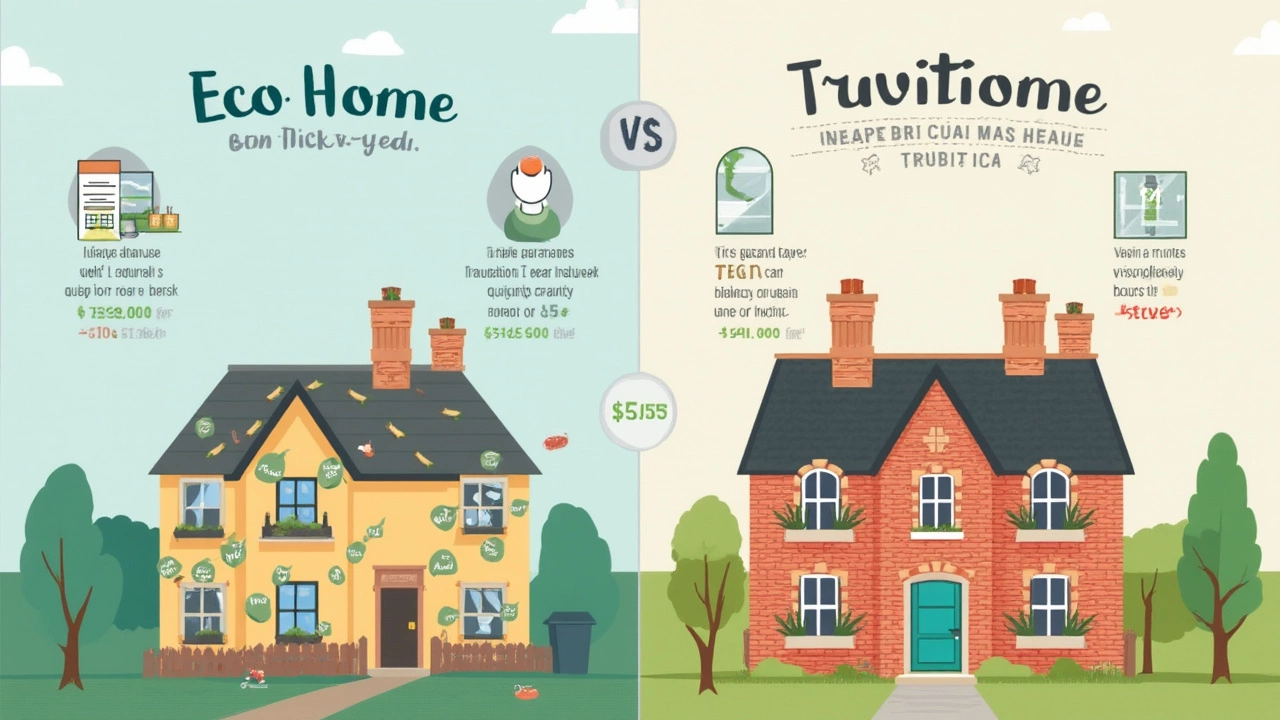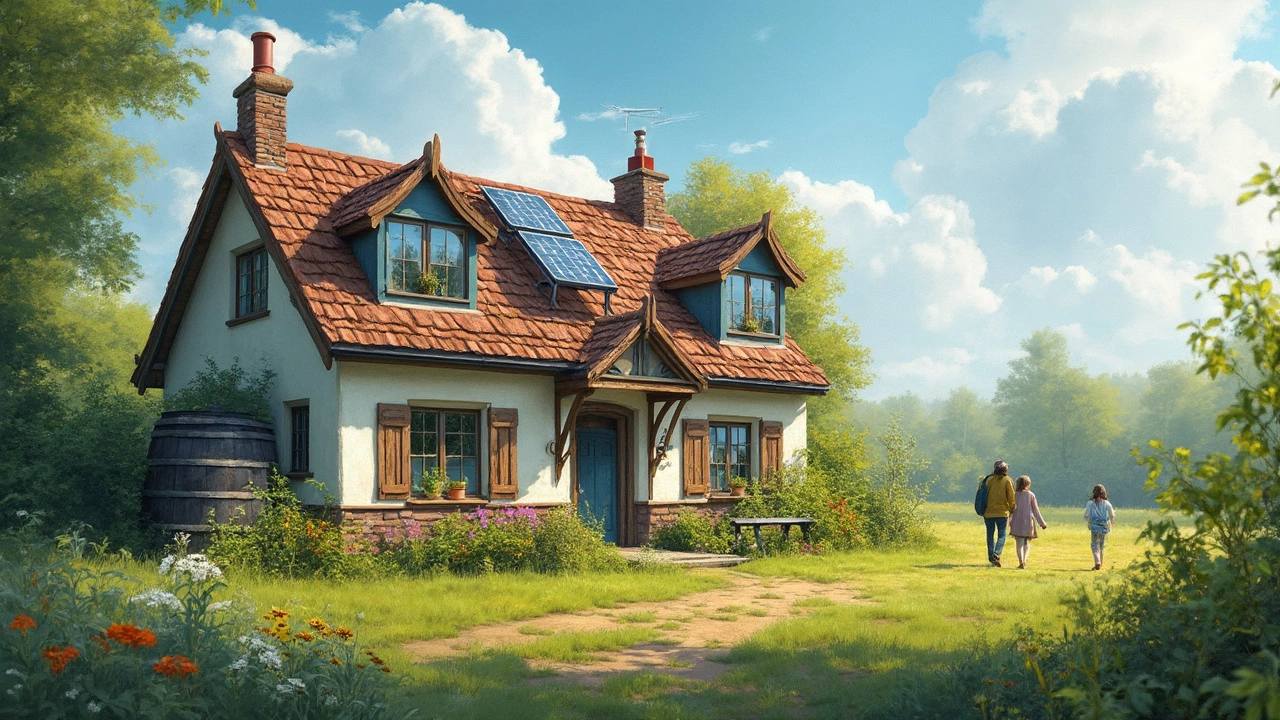Most folks think building an eco-friendly house will swallow up their savings. The price tag can look scary next to a regular home. But here’s the thing: a lot depends on what you want, where you live, and how deep you want to go green.
Not all eco-houses are built the same. The moment you swap in solar panels or fancy insulation, sure, the costs tick up. But it’s not all about shelling out extra cash. Some green materials, like recycled wood or simple straw bales, can be cheaper than you’d expect if you know where to look.
If you’re dreaming about a cute eco-friendly cottage, you don’t always have to break the bank or splurge on all the latest tech. It’s about finding the sweet spot between upfront costs and the savings you’ll stash away every month on lower utility bills.
And here’s a quick tip: government grants and rebates for green features aren’t going anywhere soon. So before you ditch the idea, see what help’s available in your area. Sometimes what looks pricey at first glance isn’t so bad once you count up the long-term savings.
- Breaking Down the Price Tag
- What Makes Eco Homes Cost More… or Less
- Savings That Add Up Over Time
- Smart Choices for Your Budget
- Is an Eco-Friendly Cottage Worth It?
Breaking Down the Price Tag
If you want to know how expensive eco-friendly houses really are, you gotta get into the nitty gritty numbers. Some people get sticker shock looking at green homes and just walk away, but a closer look gives you the real picture.
For starters, the average cost to build a standard house in the U.S. runs from $150 to $250 per square foot. When you bring in eco-friendly upgrades, the base cost goes up about 10% to 20% on average. That means a 1,500 square foot eco home could set you back $247,500 to $450,000, depending on how green you want to go and where you build.
| Feature | Extra Initial Cost | Potential Yearly Savings |
|---|---|---|
| Solar Panels | $12,000 - $24,000 | $1,000 - $1,500 |
| High R-Value Insulation | $2,000 - $4,000 | $400 - $600 |
| Triple-Pane Windows | $8,000 - $15,000 | $200 - $400 |
| Rainwater Harvesting | $2,500 - $7,000 | $100 - $300 |
Keep in mind, these numbers are ballpark—costs change by region, builder, and what deals you can score. A big chunk of the price comes down to things you choose: are you using locally sourced wood or shipping in bamboo from overseas? Is your eco-friendly houses plan packed with smart home gadgets, or are you just sticking to the basics like better insulation and low-flow taps?
Also, building a green home from scratch usually costs more up front than a standard build, but retrofitting an old cottage with green upgrades can be pretty pricey too, especially if you need to fix old wiring or replace the roof. If you make a list of "must-have" eco features and stick to just the most important ones, you'll get a clearer idea of the bottom line. And don’t forget, over the years, the savings from low energy and water bills can start paying you back in ways traditional homes just can’t.
What Makes Eco Homes Cost More… or Less
If you’ve ever asked yourself, “Why do some eco-friendly houses cost so much?” you’re definitely not alone. It’s mostly about what goes into the building and how far you want to go with green features. Here’s what really bumps up (or even lowers) the price tag:
- Materials: Natural or recycled materials like bamboo, reclaimed wood, or sheep’s wool insulation sound fancy, but prices vary a ton. Sometimes they’ll cost more up front, but they last longer and are healthier to live with.
- Technology: Good solar panels aren’t cheap, and high-efficiency heat pumps or triple-pane windows can be pricey. But every upgrade adds something to your final bill.
- Labor: Builders who really know their stuff about eco homes tend to charge more. Building green is a specialized skill, so some old-school companies might cost less, but you lose out on know-how.
- Location: Prices swing big depending on where you build. Urban eco homes might face higher land and labor costs, while rural projects could save on overhead but pay extra for shipping materials.
- Certifications: Want that official stamp from LEED or Passivhaus? It’s not free. These green labels show you’ve met tough standards, but they mean higher paperwork and inspection fees.
Here’s a real look at average cost bumps compared to standard homes. These are ballpark figures for the U.S. (as of late 2024):
| Feature | Extra Cost Per Square Foot |
|---|---|
| Basic Green Insulation | $2 - $4 |
| Solar Panels | $15 - $25 |
| Triple-Glazed Windows | $8 - $15 |
| Rainwater Collection | $2 - $8 |
| LEED Certification (Total Project) | $2,500 - $10,000 |
But there are smart ways to keep costs down. Salvaged building materials can be a bargain if you know where to hunt. DIY projects, like simple compost toilets or rainwater barrels, can cost peanuts compared to pro setups.
And remember, your main keyword here is eco-friendly houses. Not every green home has to feel expensive. It comes down to trade-offs and personal choices. Some folks splurge on solar roofs, others stick with the basics. Either way, once you know where your money’s really going, it’s easier to plan—and maybe even save more than you expected.

Savings That Add Up Over Time
Here’s where eco-friendly houses start to make real sense for your wallet. While the starting price can be higher, the long-term payback often surprises people. Let’s talk numbers, not wishful thinking.
First, utility bills. An eco-friendly house often uses way less energy and water than a regular home. The Environmental Protection Agency (EPA) says energy-efficient homes cut average utility costs by up to 30%. With heat pumps, thick insulation, and solar panels, some folks spend under $50 a month to power a whole cottage—even in winter.
Here’s a look at how common upgrades can save you money every year:
| Feature | Average Added Cost | Yearly Savings | Payback Time |
|---|---|---|---|
| Solar panels | $12,000 | $1,200 | 10 years |
| High-efficiency windows | $5,000 | $300 | 16 years |
| Extra insulation | $2,500 | $350 | 7 years |
| Heat pump | $6,000 | $700 | 8.5 years |
Water-saving gadgets like low-flow shower heads and dual-flush toilets can chop your water bill by 20% or more. Some areas even give rebates for installing rainwater tanks or smart irrigation.
Maintenance costs play a big part too. Eco-friendly materials like metal roofs or composite decking tend to last longer and need less fixing, which means fewer surprises down the road.
- If you’re in a region with good sunlight, solar power alone can wipe out much of your electricity bill.
- Government tax credits and rebates cut startup costs by thousands, making those green extras a lot more affordable.
- If you ever sell your house, green certifications like LEED or ENERGY STAR might boost your resale value 5–10% faster than regular homes.
So, while that first receipt may sting more than a standard build, these savings sneak up year by year. Before you know it, the cottage starts to pay you back—on its monthly bills, its repair budget, and maybe even its future price tag if you ever decide to move.
Smart Choices for Your Budget
Going green doesn’t have to mean going broke. The trick is picking upgrades that give you the most bang for your buck. Instead of springing for every fancy eco feature, focus on changes that quickly shrink bills or add solid value to your place.
First up: insulate, insulate, insulate! Good insulation keeps warm air in during winter and out during summer. This simple step can chop your heating and cooling costs by up to 40%. Spray foam and cellulose insulation work well, but don’t ignore basic options like thick curtains or weatherstripping—they’re cheap but effective.
Next, update your lighting and appliances. Swapping out old-school bulbs for LEDs uses up to 75% less energy. Energy Star-rated fridges and washers might cost a little more, but the monthly savings stack up quickly. When you go appliance shopping, look for the Energy Star sticker—it’s an easy win.
Water use is another spot to trim bills. Low-flow toilets, faucets, and showerheads can cut your water use by 20-60%. That’s not just good for the planet; it’s great for your wallet, especially when water rates go up.
Solar panels have a rep for being pricey, but local incentives can slice the cost and sometimes leasing is an option with zero upfront cash. If solar is still out of reach, look at solar water heaters—they’re cheaper and still make a dent in energy use.
Here are a few budget-smart moves if you’re eyeing a eco-friendly house but want to steer clear of debt:
- Start small: Upgrade lighting and seal drafts first, then work up to bigger changes when you can afford it.
- Shop secondhand: Used or reclaimed building materials are easier on the wallet and the environment.
- Ask your contractor: Some builders have partnerships for discounts on green supplies.
- Check for rebates: Local governments and utility companies often dish out cash back or tax breaks for eco upgrades.
- DIY when safe: Painting with low-VOC paint or installing weatherstripping is easy, fast, and saves on labor costs.
By mixing these smart strategies, you can make your cottage greener, cheaper to run, and just as comfy—without emptying your pockets.

Is an Eco-Friendly Cottage Worth It?
So, does the price of an eco-friendly cottage match up to the value you get? It’s a big question—and a lot of people get stuck because of sticker shock. But if you look closer, you’ll notice the payout isn’t just about the cost of wood or solar panels. It's about savings, comfort, and impact on your everyday life.
Upfront, you’ll probably spend more building or buying a eco-friendly house. According to the U.S. Department of Energy, green homes can cost 5%–15% more to build than regular houses. But over the years, the money you save on energy, water, and even repairs can tip the scale back in your favor.
| Feature | Added Cost (Upfront) | Estimated Yearly Savings |
|---|---|---|
| Solar Panels | $10,000–$20,000 | $800–$2,000 |
| High-Efficiency Insulation | $2,000–$7,000 | $500–$1,000 |
| Rainwater Collection | $2,500–$5,000 | $300–$700 |
| Energy-Star Appliances | $500–$2,000 | $100–$300 |
Here’s why it matters: Utilities keep getting pricier. Having a cottage that sips energy instead of guzzling it means your bills may go down as everyone else's go up. Plus, eco-friendly homes often need less maintenance in the long run. No one likes surprise repair costs, right?
- If you’re planning to keep the cottage for years, you could actually come out ahead just from lower utility bills. Most homeowners see their investment pay off in less than 10 years.
- Eco homes sell faster and sometimes for more money. According to realtor.com, green-certified homes averaged 10% higher resale value in 2024.
- There’s the health angle, too—better air quality and fewer chemicals, which can mean fewer trips to the doctor, especially if you have allergies or asthma.
And don’t forget, there’s local and federal support for green building. In 2025, U.S. homebuyers can snag up to $7,500 in tax credits just for energy-efficient upgrades. Some states even kick in extra incentives for new roofs or windows.
If you want steady savings, a more comfortable place, and a smaller footprint on the planet, an eco-friendly cottage isn’t just a brag-worthy choice. For many, it actually pays off in the long run.
